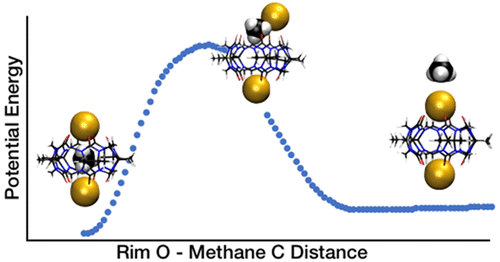当前位置:
X-MOL 学术
›
J. Phys. Chem. A
›
论文详情
Our official English website, www.x-mol.net, welcomes your feedback! (Note: you will need to create a separate account there.)
Barriers for Extrusion of a Guest from the Interior Binding Cavity of a Host: Gas Phase Experimental and Computational Results for Ion-Capped Decamethylcucurbit[5]uril Complexes
The Journal of Physical Chemistry A ( IF 2.9 ) Pub Date : 2018-11-08 00:00:00 , DOI: 10.1021/acs.jpca.8b08031 Samuel M. Hickenlooper 1 , Conner C. Harper 1 , Brigham L. Pope 1 , Daniel N. Mortensen 1 , David V. Dearden 1
The Journal of Physical Chemistry A ( IF 2.9 ) Pub Date : 2018-11-08 00:00:00 , DOI: 10.1021/acs.jpca.8b08031 Samuel M. Hickenlooper 1 , Conner C. Harper 1 , Brigham L. Pope 1 , Daniel N. Mortensen 1 , David V. Dearden 1
Affiliation

|
Factors affecting the extrusion of guests from metal ion-capped decamethylcucurbit[5]uril (mc5) molecular container complexes are investigated using both collision-induced dissociation techniques and molecular mechanics simulations. For guests without polar bonds, the extrusion barrier increases with increasing guest volume. This is likely because escape of larger guests requires more displacement of the metal ion caps and, thus, more disruption of the ion-dipole interactions between the ion caps and the electronegative rim oxygens of mc5. However, guests larger than the optimum size for encapsulation displace the ion caps prior to collision-induced dissociation, resulting in less stable complexes and lower dissociation thresholds. The extrusion barriers obtained for guests with polar bonds are smaller than those obtained for similarly sized guests without polar bonds. This is likely because the partial charges on the guest allow electrostatic interactions with the ion cap and rim oxygens of mc5 during extrusion, thus stabilizing the extrusion transition state and reducing the extrusion barrier. Results from this study demonstrate simple principles to consider for designing host–guest complexes with specific guest-loss behaviors. Similar trends are observed between the experimental and computational results, demonstrating that molecular mechanics simulations can be used to approximate the relative stability of mc5 molecular container complexes and likely those of other similar complexes.
中文翻译:

来宾从宿主的内部结合腔中挤出的障碍:离子封顶的十甲基葫芦[5]尿嘧啶配合物的气相实验和计算结果。
利用碰撞诱导离解技术和分子力学模拟研究了影响金属离子封顶的十甲基葫芦[5]尿素(mc5)分子容器复合物中客体挤出的因素。对于没有极性键的客人,挤压屏障会随着客人体积的增加而增加。这可能是因为较大的客人逸出需要金属离子帽的更多位移,因此,离子帽与mc5的负电性氧之间的离子-偶极相互作用的破坏更多。但是,大于最佳封装尺寸的宾客在碰撞诱导解离之前将离子帽移位,从而导致不稳定的络合物和更低的解离阈值。为客人提供的挤压壁障极性键小于没有极性键的类似大小的客人获得的极性键。这可能是因为客体上的部分电荷在挤压过程中允许与mc5的离子帽和边缘氧发生静电相互作用,从而稳定了挤压转变状态并降低了挤压壁垒。这项研究的结果表明,在设计具有特定客流损失行为的接待宾客体时要考虑的简单原则。在实验结果和计算结果之间观察到相似的趋势,表明分子力学模拟可用于估算mc5分子容器复合物以及其他类似复合物的相对稳定性。
更新日期:2018-11-08
中文翻译:

来宾从宿主的内部结合腔中挤出的障碍:离子封顶的十甲基葫芦[5]尿嘧啶配合物的气相实验和计算结果。
利用碰撞诱导离解技术和分子力学模拟研究了影响金属离子封顶的十甲基葫芦[5]尿素(mc5)分子容器复合物中客体挤出的因素。对于没有极性键的客人,挤压屏障会随着客人体积的增加而增加。这可能是因为较大的客人逸出需要金属离子帽的更多位移,因此,离子帽与mc5的负电性氧之间的离子-偶极相互作用的破坏更多。但是,大于最佳封装尺寸的宾客在碰撞诱导解离之前将离子帽移位,从而导致不稳定的络合物和更低的解离阈值。为客人提供的挤压壁障极性键小于没有极性键的类似大小的客人获得的极性键。这可能是因为客体上的部分电荷在挤压过程中允许与mc5的离子帽和边缘氧发生静电相互作用,从而稳定了挤压转变状态并降低了挤压壁垒。这项研究的结果表明,在设计具有特定客流损失行为的接待宾客体时要考虑的简单原则。在实验结果和计算结果之间观察到相似的趋势,表明分子力学模拟可用于估算mc5分子容器复合物以及其他类似复合物的相对稳定性。


























 京公网安备 11010802027423号
京公网安备 11010802027423号